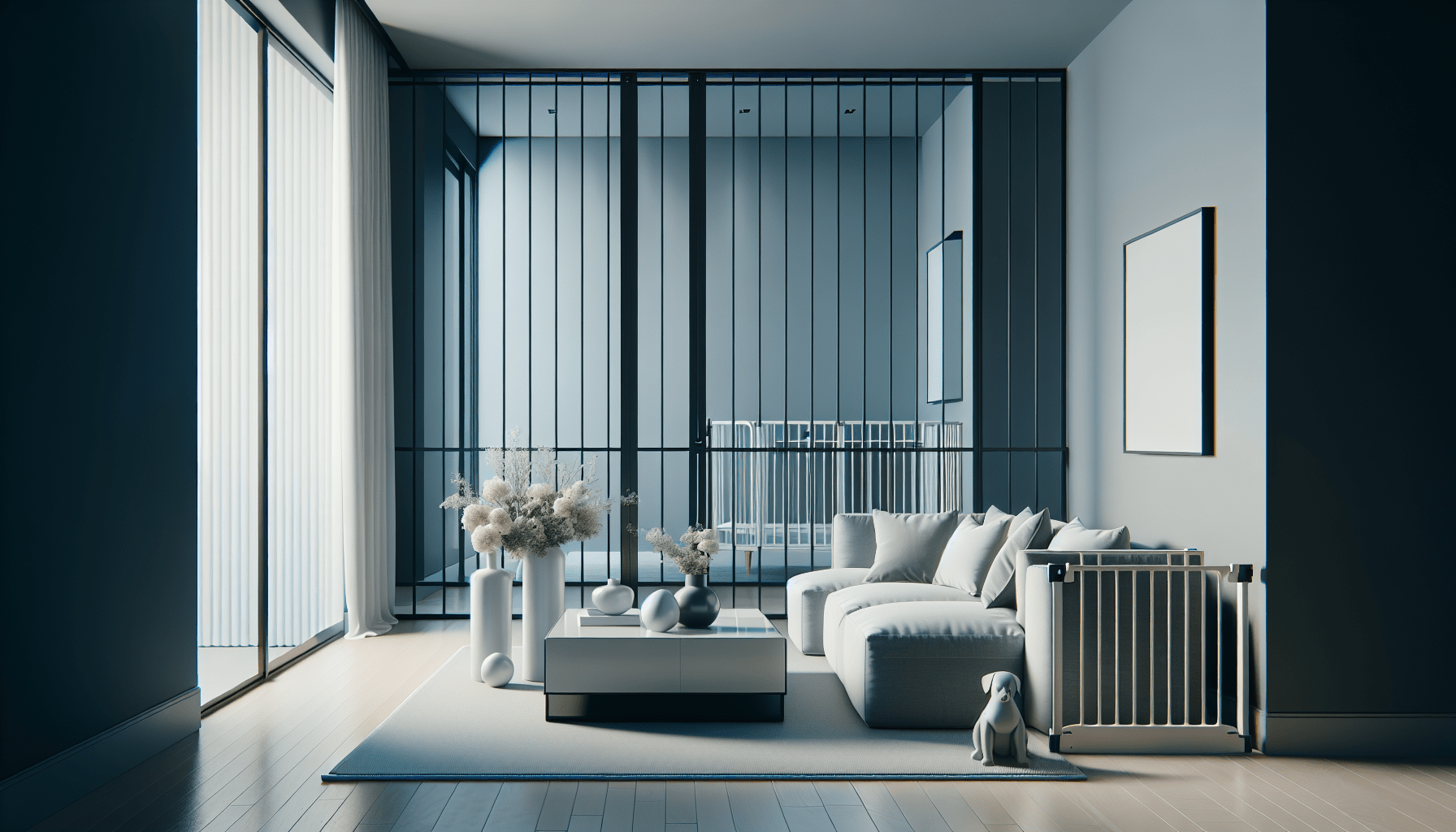Finding the perfect balance between loving your pets and maintaining a clean, comfortable space can be challenging, especially if allergies are an issue. In “How to Create a Pet-Free Zone in Your Living Room,” you’ll learn practical tips and strategies to carve out a specific area in your home where your furry friends aren’t allowed. This guide will help you enjoy a breath of fresh air and a tidy living space, all while ensuring your pets still have plenty of places to roam and play. Have you ever wondered how you can maintain a comfortable living space while managing pet allergies or simply keeping certain areas of your home pet-free? Whether you suffer from allergies or just want a clean, pet-free zone in your living room, creating such a space can make a significant difference in your quality of life. Here’s a friendly and informative guide on how to create a pet-free zone in your living room for allergy relief and overall well-being.

Understanding the Need for a Pet-Free Zone
Living with pets can be wonderful, but they can also bring along certain challenges, particularly for those with allergies. Recognizing why you might need a pet-free zone in your living room is the first step.
Health Reasons
If you or a family member is allergic to pet dander, creating a pet-free zone can drastically improve comfort and health. Symptoms can range from mild sneezing and itching to more severe reactions like difficulty breathing.
Cleanliness and Maintenance
Pets can shed fur, dirt, and other debris that can make cleaning a tiresome task. By designating a pet-free area, you can enjoy a cleaner and more manageable space.
Planning Your Pet-Free Zone
Once you’ve identified the need, it’s time to plan your pet-free zone. Here’s how you can approach this step by step.
Define the Area
Determine which part of your living room will be strictly off-limits for your furry friends. This could be the entire room or a specific section, such as the sitting area or near upholstered furniture.
Establish Boundaries
Clearly define and set up physical boundaries to separate the pet-free zone. This makes it easier for your pets to understand where they are not allowed.
Communicate with Your Family
Ensure that everyone in your household understands the new rules and the importance of keeping the pet-free zone truly pet-free. Consistency is key.
Setting Up Physical Barriers
Creating physical barriers is one of the most effective ways to maintain a pet-free zone. This doesn’t necessarily mean building walls—there are more straightforward and convenient solutions.
Baby Gates
Baby gates are excellent for keeping pets out of certain areas without obstructing the view or affecting the overall aesthetics of your living room. Plus, they are easy to install and remove.
Furniture Arrangement
Strategically arrange your furniture to create natural barriers. For example, placing a couch, table, or bookshelf in a way that blocks a specific area can effectively prevent pets from accessing it.
Decorative Screens
Decorative screens can also serve as stylish dividers to keep pets out while adding to your room’s decor.
Choosing Pet-Free Zone Materials
The materials you select for your pet-free zone can make a significant difference in maintaining its cleanliness and allergen-free status.
Floors
Choose flooring materials that are easy to clean and do not trap allergens. Hardwood, laminate, or vinyl flooring are excellent choices over carpets, which can harbor pet dander and fur.
Furniture
Opt for furniture that is less likely to attract and retain pet hair and dander. Leather or tightly-woven fabric furniture can be good options.
Rugs and Curtains
If you must use rugs, go for washable ones that can be easily cleaned. Similarly, choose curtains that are made from materials resistant to pet hair and dander or that can be washed regularly.
Cleaning and Maintenance
Keeping your pet-free zone clean is crucial for its success. Regular cleaning will prevent the accumulation of pet dander and other allergens.
Regular Dusting
Dust surfaces frequently using microfiber cloths, which are more efficient at trapping dust and allergens compared to regular dust cloths.
Vacuuming
Invest in a vacuum with a HEPA filter, which can capture tiny particles and ensure that your space remains as allergen-free as possible. Regular vacuuming, including furniture and crevices, is essential.
Air Purifiers
Using air purifiers with HEPA filters can greatly improve air quality by trapping allergens that are not visible to the naked eye.
Training Your Pets
Training your pets to respect the pet-free zone is critical. Here’s how you can train them effectively and humanely.
Positive Reinforcement
Use positive reinforcement methods to train your pets. Reward them with treats, praise, or playtime when they respect the boundaries of the pet-free zone.
Consistent Commands
Use consistent commands to make it clear to your pets what areas are off-limits. Phrases like “stay out” or “no pets here” can be helpful.
Supervision
Initially, supervise your pets closely to ensure they adhere to the new rules. Over time, they will learn to stay out of the restricted area on their own.

Dealing with Common Challenges
Creating a pet-free zone isn’t without its challenges. Here are some common issues you might face and how to deal with them.
Persistent Pets
Some pets may be persistent and try to enter the pet-free zone repeatedly. In such cases, reinforce training regularly and consider adding extra barriers if necessary.
Guest Pets
If you have guests who bring their pets along, kindly request that they respect your pet-free zone. Provide alternative spaces where guest pets can be comfortable.
Accidental Intrusions
Occasional intrusions by your pets are bound to happen. When they do, clean the area immediately to maintain the pet-free status and re-establish boundaries through training.
Making the Rest of the House Pet-Friendly
To ensure your pets are comfortable and don’t feel excluded, make the rest of your home as pet-friendly as possible.
Comfortable Pet Spaces
Create cozy and inviting spaces in other parts of your home specifically for your pets. This may include comfy beds, play areas, and accessible water and food dishes.
Engaging Toys
Provide plenty of engaging toys to keep your pets entertained and distracted from the pet-free zone.
Alternate Relaxation Spots
Place relaxing spots like rugs or pet beds near windows or in sunny areas where your pets enjoy lounging.
Health Benefits of a Pet-Free Zone
Implementing a pet-free zone has numerous health benefits, especially for those who suffer from allergies.
Reduced Allergens
A dedicated pet-free zone means significantly fewer allergens in that area, leading to fewer allergy symptoms like sneezing, coughing, and itchy eyes.
Better Air Quality
Cleaner air free from pet dander and fur can make a noticeable difference in overall health, particularly for those with asthma or other respiratory conditions.
Improved Sleep
If your pet-free zone includes your living room where you occasionally nap or unwind, maintaining an allergen-free environment can lead to better sleep quality.
Psychological Benefits
Creating a pet-free zone isn’t just about physical health—it can also contribute positively to mental well-being.
Peace of Mind
Knowing you have a clean, allergen-free space to retreat to can significantly reduce stress and anxiety, particularly for those sensitive to allergens.
Enjoyment of Space
A well-maintained and clean living area is more enjoyable and inviting, allowing you to fully relax and enjoy your time at home.
Balanced Pet Ownership
Achieving a balance where you can enjoy your pets while also having a clean, allergen-free space can lead to a more harmonious living situation for both you and your pets.
Common Mistakes to Avoid
In the process of creating a pet-free zone, it’s easy to make some common mistakes. Here’s how to avoid them.
Inconsistent Rules
Inconsistency can confuse your pets and make it harder for them to learn boundaries. Make sure all household members are enforcing the same rules and commands.
Lack of Maintenance
Neglecting regular cleaning and maintenance can quickly lead to the buildup of allergens, defeating the purpose of your pet-free zone. Stick to a consistent cleaning schedule.
Insufficient Barriers
Ensure that your barriers are sufficient to keep pets out. Sometimes, additional barriers or adjustments are necessary to make them effective.
FAQs
Q: Can I use essential oils to reduce pet allergens?
A: While some essential oils have properties that can reduce allergens, it’s crucial to choose pet-safe oils. Always consult with your vet before using essential oils around your pets.
Q: What if my pet refuses to stay out of the pet-free zone?
A: If your pet is particularly insistent, it may take more time and training to establish boundaries. Using more robust barriers and reinforcing positive behavior can help over time.
Q: Is it possible to make just part of the living room pet-free?
A: Absolutely! You can designate a specific section of your living room as pet-free using furniture arrangement, screens, or baby gates to keep pets in designated areas.
Q: How often should I clean my pet-free zone?
A: Regular cleaning is essential. Aim to dust and vacuum at least once a week, and use air purifiers consistently to maintain air quality.
Q: How can I manage dander if I have a pet-free zone but still want to enjoy time with my pets?
A: Grooming your pets regularly, using air purifiers, and washing your hands and clothing after pet interactions can help minimize the spread of allergens.
Conclusion
Creating a pet-free zone in your living room for allergy relief is not only possible but also highly beneficial for both your health and peace of mind. Through thoughtful planning, effective training, and regular maintenance, you can enjoy a clean, allergen-free space while still cherishing the companionship of your furry friends. By balancing these elements, you’ll create a harmonious living environment that caters to the needs of everyone in your household, including your pets.
